A Makeover for the Barnes Foundation
-
 Photograph reproduced with permission of the Barnes Foundation™.
Photograph reproduced with permission of the Barnes Foundation™.Late last year, a judge ruled that the Barnes Foundation could relocate its $25 billion art collection from suburban Merion, Pa., where it had been situated for the last 80 years, to downtown Philadelphia. The deficit-ridden institution wants to move in order to gain a higher profile and attract more visitors. To do so, it plans to construct a new building. The original Barnes Foundation (at right) resembles a large residence; there are two dozen rooms. It was designed in 1924 by Paul Philippe Cret in a highly simplified Italian Renaissance style that presaged the "stripped Classicism" for which he became famous. Stripped classicism, which combined Modernist abstraction with Classical proportions and composition, went out of fashion after the Second World War, so it's unlikely that a new museum will be an updated version of that spare, sophisticated style. What else might it be—and what might a new building mean for the famously idiosyncratic Barnes Foundation?
-
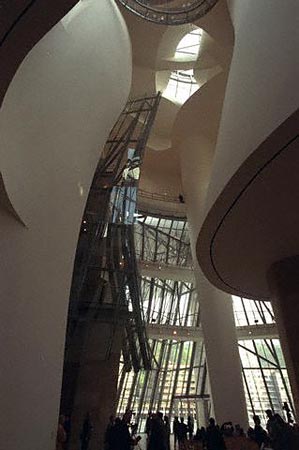 Photograph of the Guggenheim Museum in Bilbao © Jacques Pavlovsky/Sygma/Corbis.
Photograph of the Guggenheim Museum in Bilbao © Jacques Pavlovsky/Sygma/Corbis.No one builds a museum today without casting an eye on the Guggenheim in Bilbão (at right). An envious eye—for Frank Gehry's masterpiece seems to have it all: artistic originality, visceral excitement, and popularity. Architects have sometimes enjoyed celebrity—think of I.M. Pei—and sometimes avant-garde acclaim, like Louis Kahn. But not since the other Frank (Lloyd Wright) has an architect achieved both. Gehry's secret is that under all the titanium wraps is a very traditional architect who solves practical problems and provides the public with a good deal of pleasure in the process. While Gehry is a Modernist, he has undermined many of Modernism's dicta: His buildings don't dramatize structure; their forms don't follow their functions; the interiors appear disconnected from the exteriors. These are definitely not machines for living in, as Le Corbusier hoped. Part of Gehry's appeal, in fact, is a certain degree of insouciance and goofy imprecision.
-
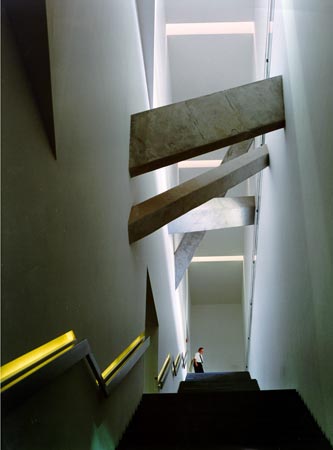 Photograph of the Jewish Museum, Berlin, courtesy KRT.
Photograph of the Jewish Museum, Berlin, courtesy KRT."Goofy" is not a word one would use about Gehry's younger contemporaries, the Men (and Women) in Black. The work of architects such as Herzog & De Meuron, Zaha Hadid, and Daniel Libeskind tends to be fashionably tortured and angst-ridden. Its slightly off-putting qualities are precisely what make it attractive to art museums, which want to be popular but fear being accused of pandering to the public. Buildings like Libeskind's Jewish Museum in Berlin (at right), for example, exhibit a joyless kind of stripped Modernism, daring onlookers to indulge in anything as base and middle-brow as pleasure. Only intellectual enjoyment is allowed, and the design comes with a healthy serving of jargon-laden theory—and lots of cheerless zinc. It's hard to imagine the Barnes' 181 sunny Renoirs in such a setting.
-
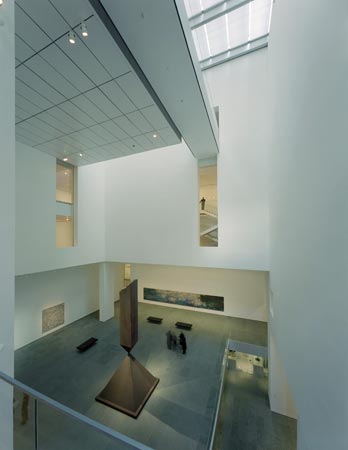 Photograph of the Donald B. and Catherine C. Marron Atrium, Museum of Modern Art, © Timothy Hursley.
Photograph of the Donald B. and Catherine C. Marron Atrium, Museum of Modern Art, © Timothy Hursley.The trouble with eye-popping buildings, whether by Gehry or by Hadid, is this: While everyone enjoys fireworks, no one wants fireworks every night. Shock and awe soon pale in a museum building visited many times over. Moreover, there is a point where dramatic architecture is in danger of overwhelming the art. What is needed is a degree of old-fashioned restraint. The museum world was reminded of this when the Museum of Modern Art recently unveiled its major expansion. Yoshio Taniguchi, its architect, provided plenty of drama (at right), but he couched it in a minimalist vocabulary. While his minimalism can be aggressively reductive in the museum's public spaces, in the galleries it provides a neutral (if somewhat bland) setting for the works of art. Neutrality is not what the Barnes Foundation needs. Albert C. Barnes, the wealthy doctor and medicine manufacturer who personally assembled the collection, had strong and original ideas about art, and one would hate to see his life's work subsumed in a muffled atmosphere of good taste.
-
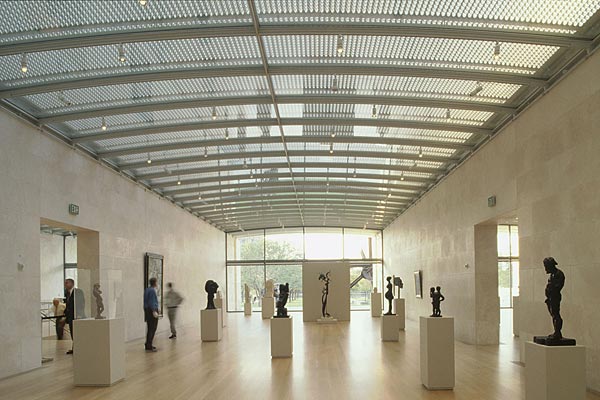 Photograph of the Nasher Sculpture Center, Dallas, by Michel Denancé.
Photograph of the Nasher Sculpture Center, Dallas, by Michel Denancé.Although Frank Lloyd Wright's Guggenheim Museum is the original art-museum-as-instant-architectural-icon, the modern reincarnation of this idea was the Centre Pompidou in Paris, which opened in 1977. Its fussy and impractical High Tech style had little impact on museum design, but one of its architects, Renzo Piano, has gone on to build many other museums, including the exceptional Menil Collection in Houston.* Another private Texas museum designed by Piano opened recently, the Nasher Sculpture Center in Dallas (at right). Simply conceived and beautifully built, it is restrained but not minimalist, and while the building defers to the works of art, it maintains a strong architectural presence. Piano does not have a trademark style, which may be why he is so much in demand (he is currently designing extensions to museum in Boston, New York, and Los Angeles). But his low-key approach would be severely tested by the Barnes collection, which demands more than a polite, albeit elegant, container.
*Correction, April 27, 2005: An earlier version of this piece mistakenly stated that the Menil Collection is in Dallas. It is in Houston.
-
 Photograph © Barnes Foundation™.
Photograph © Barnes Foundation™.Albert Combs Barnes was more than simply a wealthy collector. He assembled the finest collection of modern art in the world, he did so on his own, and he did so early (his collection was largely complete four years before MoMA was even founded). He was a serious art scholar who wrote several books on art and art education, as well as monographs on Renoir, Cézanne, and Matisse, whom he knew well. Barnes had strong ideas about how art should be displayed. He disliked distracting captions. He juxtaposed paintings and furniture, mixing art of different periods and placing famous and lesser-known painters side by side. He also interspersed his collection of Pennsylvania Dutch hardware among the Impressionists and the Matisse murals (at right). The eccentric, intimate rooms are unlike anything one finds in a well-mannered contemporary museum. Instead, they recall Isabella Stewart Gardner's idiosyncratic palazzo in Boston, or the comfortable domestic atmosphere of the Phillips Collection in Washington, D.C. Like them, the Barnes Foundation is a personal collection; that is something that a new building must take into account.
-
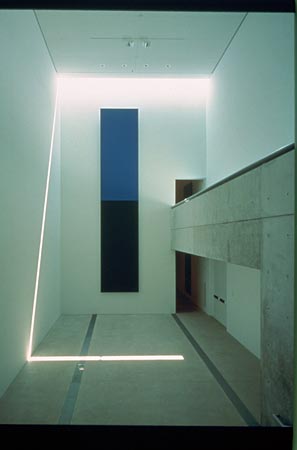 Photograph of the Pulitzer Foundation by Robert Pettus.
Photograph of the Pulitzer Foundation by Robert Pettus.The Pulitzer Foundation in St. Louis is an intensely personal museum. Its permanent collection is represented chiefly by only two artists, Ellsworth Kelly and Richard Serra, who created site-specific works for the building. The Pulitzer is open to the public two days a week, and then only by appointment. Barnes, who set up his foundation as a school and did not admit the public, would have appreciated that. It's harder to say what he would have thought of Tadao Ando's architecture. Like his countryman Taniguchi, Ando deploys a minimum palette of materials, but thanks to his masterful manipulation of natural light, the result is unexpectedly sensuous (at right). Nevertheless, the atmosphere at the Pulitzer is decidedly monastic. Barnes had Cret build the gallery walls out of burlap-covered wood, so he could hang pictures and objects wherever he wanted, one above the other, from floor to ceiling. This lively approach would undermine Ando's ordered, Zenlike interiors.
-
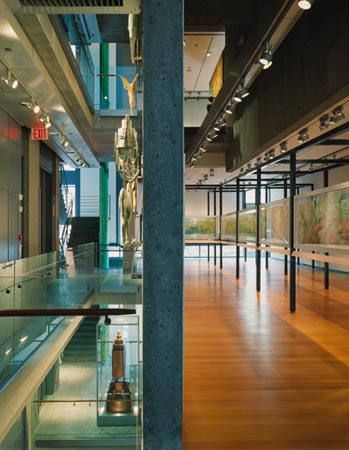 Photograph of the American Folk Art Museum © Michael Moran.
Photograph of the American Folk Art Museum © Michael Moran.The American Folk Art Museum is a tiny museum shoehorned into a narrow lot on West 53rd Street in New York City. The extremely varied collection is housed in a building designed by Tod Williams and Billie Tsien. Their architectural style is an unusual blend of Modernism and handicraft, of industrial and man-made materials, as rich, in its own way, as any Baroque interior (at right). Instead of the cramped, ascetic taste of the Men in Black, or the self-consciously Good Taste of MoMA, we have a rich architectural collage: cherry-wood handrails, slick steel hardware, distinctly un-slick resin fiberglass panels. The methods of display are varied, too; one is always coming upon objects in unexpected places. This is one museum that might serve as a model for a modern reinterpretation of Albert Barnes' catholic vision.
-
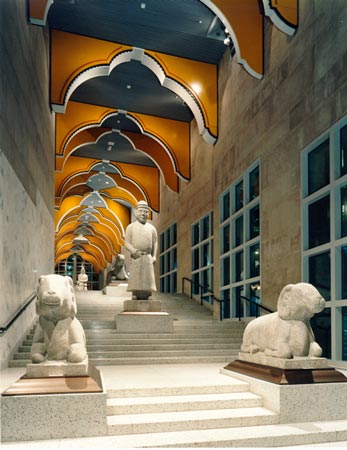 Photograph of the Seattle Art Museum by Matt Wargo.
Photograph of the Seattle Art Museum by Matt Wargo.Barnes was a maverick who carried on a lifelong feud with the Philadelphia art establishment. (The acrimony originated in 1923, when a show of Barnes' modern acquisitions was poorly received.) Perhaps his collection deserves a maverick architect. In that case one would have to look no farther than Philadelphia's Robert Venturi. In 1991, Venturi and Denise Scott Brown skillfully combined old and new motifs to accommodate a famous collection of Renaissance art in the Sainsbury Wing of the National Gallery in London, making it the most fortuitous fusion of museum architecture and art in recent memory. Their brand of mannered Modernism is also visible in the Seattle Art Museum (at right). With their irreverence, their eclectic taste, and their knowledge of the collection (they renovated Cret's building a decade ago), they would be well suited to the job of preserving Barnes' artistic intentions while housing his collection in a new building.
-
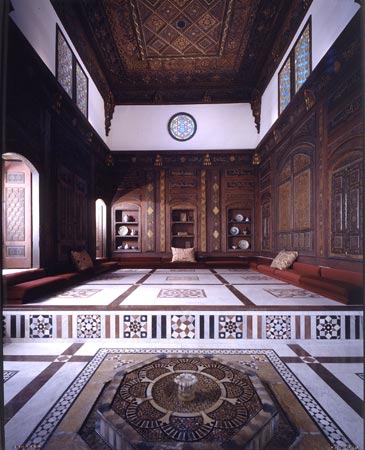 Photograph of the Nur al-Din Room © The Metropolitan Museum of Art.
Photograph of the Nur al-Din Room © The Metropolitan Museum of Art.If the Barnes Foundation is going to relocate and construct a new building, how should it interpret—or update—its founder's specific intentions about how the collection should be displayed? The best solution might be to not even try. Why not treat the galleries of the Barnes as an artistically significant artifact, and simply move them to the new location, burlap-covered walls and all? The result would resemble the transplanted historical interiors exhibited in many large museums, such as the Ottoman room at the Metropolitan Museum (at right).
The new Barnes building would engulf the old, but the new architecture, which would also house all the impedimenta of a modern art museum—gift shop, restaurant, auditorium, a grand lobby—would not need to be a replica of Cret's design. The historic interior could be wrapped in titanium swirls, polished concrete, or Mannerist facades, as taste dictated. You could have your Barnes, and eat it, too.